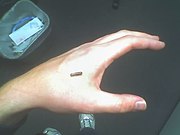Radio-frequency identification (RFID) is an automatic identification method, relying on storing and remotely retrieving data using devices called RFID tags or transponders.
An RFID tag is an object that can be applied to or incorporated into a product, animal, or person for the purpose of identification using radiowaves. Some tags can be read from several meters away and beyond the line of sight of the reader.
A basic RFID system consists of three components:
An antenna or coil
A transceiver (with decoder)
A transponder (RF tag) electronically programmed with unique information
The antenna emits radio signals to activate the tag and to read and write data to it. Antennas are the conduits between the tag and the transceiver, which controls the system's data acquisition and communication. Antennas are available in a variety of shapes and sizes; they can be built into a door frame to receive tag data from persons or things passing through the door, or mounted on an interstate toll booth to monitor traffic passing by on a freeway.
Human implants

Implantable RFID chips designed for animal tagging are now being used in humans. An early experiment with RFID implants was conducted by British professor of cybernetics Kevin Warwick, who implanted a chip in his arm in 1998. Night clubs in Barcelona, Spain and in Rotterdam, The Netherlands, use an implantable chip to identify their VIP customers, who in turn use it to pay for drinks.
In 2004, the Mexican Attorney General's office implanted 18 of its staff members with the Verichip to control access to a secure data room. (This number has been variously mis-reported as 160 or 180 staff members.
Security experts are warned against using RFID for authenticating people due to the risk of identity theft. For instance a man-in-the-middle attack would make it possible for an attacker to steal the identity of a person in real-time. Due to the resource-constraints of RFIDs it is virtually impossible to protect against such attack models as this would require complex distance-binding protocols
spottt
Categories
- Softwares (65)
- movies (56)
- games (38)
- music releases (23)
- Make Money from here (19)
- E-book (17)
- Cell Phones (13)
- Ambigram (12)
- Naruto (11)
- New Technology (10)
- mobile games (10)
- Song Lyrics (8)
- Music Karoke (6)
- Oscar nominated Movies(2008) (6)
- Crazy Gadgets (5)
- Softwares for GRE takers (5)
- WWE (5)
- E-books on GRE (4)
- Prison Break (4)
- Paintings (3)
- Disclaimer (1)
- Loose weight from here (1)
- Media player (1)
- ptc sites (1)





















March 29, 2009 at 10:44 PM
It really helps if there r more info on this